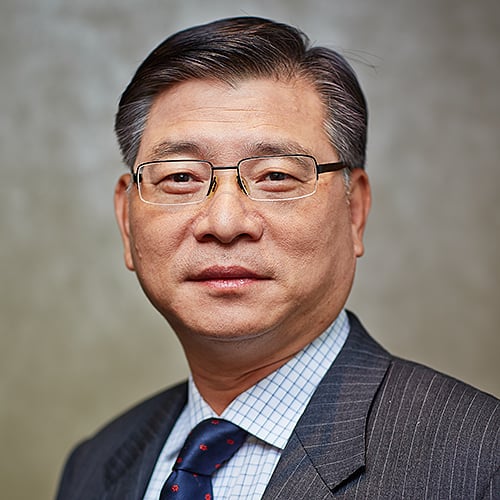Speakers:
John Groesbeek
head syndications - Asia Pacific, International Finance Corporation
head syndications - Asia Pacific, International Finance Corporation
Kian Min Low
chief development officer, JERA Asia
chief development officer, JERA Asia
Assaad Razzouk
group CEO, Sindicatum Renewable Energy
group CEO, Sindicatum Renewable Energy
Sunil Gupta
regional head of Southeast Asia and South Asia, Vena Energy
regional head of Southeast Asia and South Asia, Vena Energy
Steve Mercieca
executive director, project & export finance, Standard Chartered
executive director, project & export finance, Standard Chartered
Mukesh Sharda
managing partner, Capital Square Partners
managing partner, Capital Square Partners
Premod Thomas
head of corporate strategy, Clifford Capital
head of corporate strategy, Clifford Capital
James Chern
managing director, I Squared Capital
managing director, I Squared Capital
Sharad Somani
partner and head of infrastructure advisory, KPMG
partner and head of infrastructure advisory, KPMG
Wee Meng Thoo
head of investments, TMT sector, Leonie Hill Capital
head of investments, TMT sector, Leonie Hill Capital
Rahim Khawaja
head of capital market solutions, global structured finance, investment banking department, Asia, Sumitomo Mitsui Banking Corporation
head of capital market solutions, global structured finance, investment banking department, Asia, Sumitomo Mitsui Banking Corporation
Marc Freydefont
global head of securitized product & solutions sales, Standard Chartered
global head of securitized product & solutions sales, Standard Chartered
Eduardo Francisco
president, BDO Capital & Investment Corporation
president, BDO Capital & Investment Corporation
Boo Hock Khoo,
former vice president, operations, Credit Guarantee and Investment Facility (CGIF)
former vice president, operations, Credit Guarantee and Investment Facility (CGIF)
Sajal Kishore
head of Asia Pacific, infrastructure & project finance, Fitch Ratings
head of Asia Pacific, infrastructure & project finance, Fitch Ratings
Seth Tan
executive director, Infrastructure Asia
executive director, Infrastructure Asia
Armand Hermawan
president director, PT Penjamin Infrastruktur Indonesia
president director, PT Penjamin Infrastruktur Indonesia
Luca Tonello,
head of Asia global structured finance, investment banking department, Asia, Sumitomo Mitsui Banking Corporation
head of Asia global structured finance, investment banking department, Asia, Sumitomo Mitsui Banking Corporation
Moderators:
Daniel Yu
editor-in-chief, The Asset
editor-in-chief, The Asset
Chito Santiago
managing editor, The Asset
managing editor, The Asset
THE types and scale of renewable investment opportunities are growing in Asia, says Sunil Gupta, Vena Energy’s regional head of Southeast Asia and South Asia.
“We’re seeing a lot more penetration in terms of where our largest operating assets are,” notes Gupta at a panel at The Asset’s 4th Asia Infrastructure Finance Leaders Dialogue held in Singapore. “The fastest-growing parts are in Japan, Taiwan, India, and Australia.”
Kian Min Low, chief development officer for Japan’s JERA Asia, agrees that there are significant investment opportunities for renewable energy in Asia. His firm, one of Japan’s largest utility companies, sees renewables as a co-generation technology along with gas, its transitional fuel.
Low also sees the integration of environmental, social and governance (ESG) criteria as something that creates opportunities for renewable energy projects. “ESG as a term now is probably taken as an alternative to climate change, and, therefore, driving the development of renewable power generation.”
However, there are some who think ESG represents a hurdle.
Assad Razzouk, group CEO, Sindicatum Renewable Energy, also doesn’t feel that ESG criteria are a hurdle, but are something designed mostly for people to hide behind.
“It’s a joke,” he says. “There’s no point in a coal plant, a pipeline or an oil refinery doing ESG criteria.” ESG integration is being done, he argues, to justify the financing of pollution-emitting facilities and shouldn’t be a blessing device for such projects.
Gupta sees no problems with ESG integration. He points out that a country’s regulatory environment, energy policy and electricity market structure are more of a hurdle to getting renewable projects approved.
Razzouk breaks Asia down into four sub-regions, each presenting different opportunities. China and India lead Asia in presenting “amazing” possibilities for renewables.
Japan, South Korea and Taiwan come third, with each, according to Razzouk, presenting “a fossil fuel personality conflicting with a renewable energy personality”. Investment opportunities there go up and down. “They’re not that reliable just yet,” he explains, “although if you have a footprint there, you’re probably doing pretty well.”
The Asean countries are last, offering the fewest opportunities. Among them, the Philippines and Vietnam are the only ones pulling their weight. But, he notes, “Asean is the laggard in renewable energy globally, behind even Africa, Latin America, behind pretty much everybody.”
Steve Mercieca, executive director, project and export finance, Standard Chartered, agrees with the stark assessment of Asean countries.
However, he notes that some of these governments and sovereigns are pushing the renewable agenda towards private investors, and that they, in turn, are trying to understand and develop the sector.
Mercieca sees opportunities in Vietnam and is astounded by the development of its solar and wind projects.
John Groesbeek, head syndications, Asia Pacific, International Finance Corporation (IFC), says IFC has been most active in India, where it has helped advise and finance 10 renewable infrastructure projects. It has also gotten involved in Thailand, China and Indonesia.
Co-lending programmes are a way of attracting more investment to renewable infrastructure projects.
Groesbeek shares that IFC’s managed co-lending partnership programmes have helped it get and scale up commitments from large institutional investors. The criteria are set up upfront, and if any project meets those criteria, the investor will automatically lend alongside IFC.
IFC’s Institutional Investor programme has a fund of US$8 billion, of which US$6 billion is committed and US$4 billion is disbursed, according to Groesbeek.
Their first investors were sovereign-related entities. “After that, we were able to attract several insurance companies from the private sector,” he says. “We really believe the co-lending or fund model is the way to move forward.”
Asia has its share of successful transitions, but the scale and success of China and India’s renewable programmes are very different from those in East and Southeast Asia.
China, Gupta notes, “may be reaching a level where, in terms of annual capacity of additional renewables, the growth may be flattening out because it already has a very high base of wind and solar. It has about 60 to 65 gigawatts (GW) of new additions every year.”
India, on the other hand, has about 15GW a year of new additions and its government is talking about ramping it up to around 30GW to 35GW per year in a very short period.
“So, if China continues to do 60 to 65GW per year and India gets up to 30 to 35GW per year, you are talking about 100GW,” Gupta states.
“That in itself is bigger than the rest of the world in terms of the scale.”
“China and India have got significantly large policy incentives to increase the rate of renewable energy generation,” Low says. “Part of that increase in growth rates has to be the decreasing costs of the installation of these facilities.”
The challenge for some of Asia’s developing countries, he adds, is to grow responsibly and reliably within their systems, some of which are fairly immature in terms of power grid and investments.
China alone, Razzouk points out, represents 50% of worldwide capacity in solar, wind and electrical cars, buses and storage. “China is kind of top of the world and Asean is at the bottom.”
A number of Asean countries with an immediate demographic need for power, Mercieca says, will see the most development in renewable resources.
But he points out, “not every country can replicate what Taiwan is doing by providing a significant tariff to early investors to mobilize the local manufacturing industry.”
Successful transitions to renewable energy need the appropriate regulatory framework to go with it.
“Without guidance from the government on the PPAs (power purchase agreements), good off-takers and appropriate off-takers, it’s very difficult to develop private sector projects,” Groesbeek notes.
Natural gas is considered in some quarters to be a good transitional source of power.
Low sees liquefied natural gas (LNG) as an attractive transitional fuel for governments and utilities to invest in, citing its abundance and cost.
Sindicatum’s Razzouk disagrees, stating that gas is not a transition fuel because the leakage involved at various stages of its production and transport make it incredibly dirty.
Besides, he notes, renewables today are cheaper, and cost is not the reason why wind and solar do not provide 100% of Asia’s power supply.
There is also debate on whether green bonds incentivize investments in renewable energy.
Green bonds do more harm than good in general, states Razzouk, and they do not incentivize investment in renewables.
Mercieca believes they can have a mobilizing effect on the sector and in Asia, there is a need for these specific instruments to be raised and geared towards renewables.
It is an asset class, he argues, that will also benefit commercial lenders by taking away a lot of their exposure.
“The bond market, the takeout market, to offset the banks’ long-term exposure is something, whichever way you look at it, whether its black or green, we would see taking more exposure to develop these assets,” says Mercieca.





.jpg)
.jpg)


